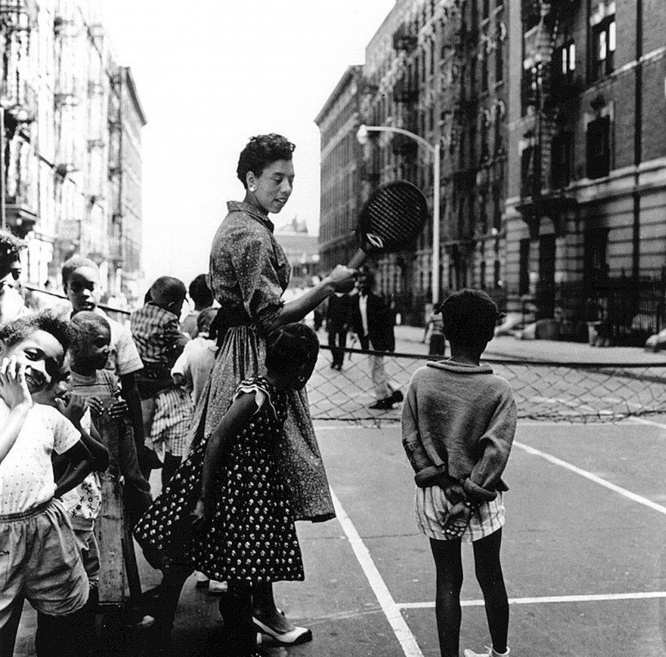Althea Gibson famously learned to swing a racket – although first a paddle racket – on the streets of Harlem in New York City as a young girl. She went on to become the first black player to play and win the singles title at Wimbledon and the U.S. Championships. She tells in this excerpt below of the how she specifically moved from hitting balls on the streets to hitting them in between the lines on the courts in her re-published autobiography “I Always Wanted To Be Somebody” (for sale and download here: https://www.amazon.com/dp/1937559971/ref=cm_sw_r_tw_dp_0B2M2GZEPYW8KJA903MV via @amazon)
The 143rd Street block my mother and father lived on was a Police Athletic League play street, which means that the policemen put up wooden barricades at the ends of the street during the daytime and closed it to traffic so we could use it for a playground. One of the big games on the street was paddle tennis, and I was the champion of the block. In fact, I even won some medals representing 143rd Street in competition with other Harlem play streets. I still have them, too. I guess I’ve kept every medal or trophy I ever won anywhere.
Paddle tennis is played on a court marked off much like a tennis court, only about half the size. You use a wooden racket instead of a gut racket, and you can play with either a sponge rubber ball or a regular tennis ball. It’s a lot different from real tennis, and yet it’s a lot like it, too. There was a musician fellow, Buddy Walker, who’s known now as “Harlem’s Society Orchestra Leader,” but who in those days didn’t get much work in the summer months and filled in by working for the city as a play leader. He was watching me play paddle tennis one day when he suddenly got the idea that I might be able to play regular tennis just as well if I got the chance. So, out of the kindness of his heart, he bought me a couple of second-hand tennis rackets for five dollars apiece and started me out hitting balls against the wall on the handball courts at Morris Park. Buddy got very excited about how well I hit the ball, and he started telling me all about how much I would like the game and how it would be a good thing for me to become interested in it because I would meet a better class of people and have a chance to make something out of myself. He took me up to his apartment to meet his wife, Trini, and their daughter, Fern, and we all talked about it.
The next thing that happened was that Buddy took me to the Harlem River Tennis Courts at 150th Street and Seventh Avenue and had me play a couple of sets with one of his friends. He always has insisted that the way I played that day was phenomenal for a young girl with no experience, and I remember that a lot of the other players on the courts stopped their games to watch me. It was very exciting; it was a competitive sport and I am a competitive sort of person. When one of the men who saw me play that first time, a Negro schoolteacher, Juan Serrell, suggested to Buddy that he would like to try to work out some way for me to play at the Cosmopolitan Tennis Club, which he belonged to, I was more than willing. The Cosmopolitan is gone now, but in those days, it was the ritzy tennis club in Harlem. All the Sugar Hill society people belonged to it.
Mr. Serrell’s idea was to introduce me to the members of the Cosmopolitan and have me play a few sets with the club’s one-armed professional, Fred Johnson, so that everybody could see what I could do. If I looked good enough, maybe some of them would be willing to chip in to pay for a junior membership for me and to underwrite the cost of my taking lessons from Mr. Johnson. Lucky for me, that’s the way it worked out. Everybody thought I looked like a, real good prospect, and they took up a collection and I bought me a membership. I got a regular schedule of lessons from Mr. Johnson, and I began to learn something about the game of tennis.

